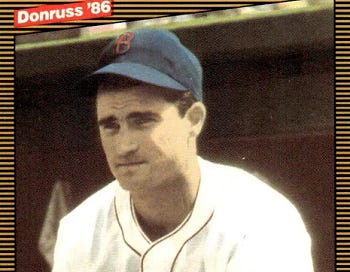When Bobby "Who?" Stepped (Back) into the Baseball Spotlight
Donruss helped us figure it all out
Note: When you click on links to various merchants in this newsletter and make a purchase, this can result in this newsletter earning a commission. Affiliate programs and affiliations include, but are not limited to, the eBay Partner Network and Amazon Associates.
1986 Donruss Highlights Bobby Doerr (#32) - Card of the Day
(affiliate link)
Most baseball fans and card collectors were pretty surprised by one of the names announced as a new Hall of Fame member in 1986.
After all, Bobby Doerr had spent most of the years between his early retirement in 1951 and the Cooperstown election(s) of 1986 in relative baseball anonymity. He was a cattle rancher in Oregon for the first half dozen of those years, until the baseball bug bit him again in 1957.
That year, the Red Sox brought Doerr back, as a scout. He held that role until 1967, when new Sox manager Dick Williams hired Doerr as the team’s first base coach. That was a magical season, of course, as Boston won their first pennant in 21 years before losing a hard-battled seven-game World Series. Doerr resigned his post in September 1969 when the team fired Williams.
The nine-time All-Star second baseman then slid out of the diamond limelight again until 1977, when he became the first hitting coach for the expansion Toronto Blue Jays. When he left that post in 1981, Doerr once again went mostly incognito for another five years.
So when the Veterans Committee announced they had elected both Ernie Lombardi and Doerr, the first reaction of many to that later name was, Bobby Who?
We soon began to learn a lot more about the man, of course, as the run-in to the Hall of Fame induction ceremony that summer revealed much of his backstory. And, by that fall, we were starting to get fresh Doerr baseball cards to help us understand his place in baseball and Red Sox history.
One of the first of those, was card #32 in the year-end Donruss Highlights set, the second such 56-card boxed set issued by Big D celebrating big moments of the just-completed baseball season. The set would return for one final run in 1987.
You can see the front of the Doerr card up above. Here is the back, with some explanation about his Hall worthiness:
(affiliate link)
There was plenty of complaining about Doerr’s election in the days, weeks, months, years, decades that followed. Even today, his name frequently comes up as one of the most undeserving Hall of Fame electees ever (though Harold Baines took some heat off of him).
Understandable, given that old buddy Ted Williams pushed Doerr’s election through as a first-year member of the Veterans Committee in 1986, coupled with Doerr’s relatively mild career totals.
Even so, Baseball Reference ranks Doerr as something like the 23rd best second baseman of all time, and there have been other players elected based on a strong but short run in the majors (Sandy Koufax and Kirby Puckett come to mind).
But no matter what you think of Doerr as a Hall of Famer, there’s no denying he holds a special place in Red Sox history, and he also “served” as the oldest living major leaguer for several months before his death in 2017.
And today is as good a day as any to remember and dig in to Doerr’s diamond legacy. That’s because Robert Pershing Doerr was born on April 7, 1918 — 107 years ago today.
The Forbidden Splinter
Speaking of Teddy Ballgame, Williams plays an imporant part in hobby history, one that goes beyond his mere greatness and the heavy-hitting cards his stature engenders. Indeed, his 1954 Bowman card — which should never have existed — helped set the stage for much of what was to come.
Read more about this iconic card, whose significance isn’t always fully appreciated in the glitz and glam of today’s hobby, in this post I wrote a few years back.






